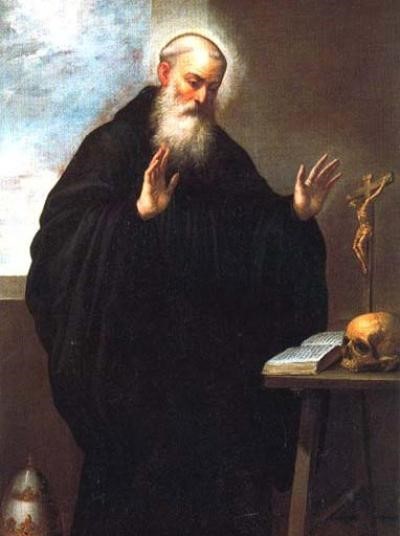
Saint of the Day of 19 May: St. Peter Celestine V, the Pope of the “Great Refusal”
A seeker of God. Pietro Angelerio da Morrone, the future Celestine, was one from a young age when he saw in the silence and beauty of nature the favourable dimension for contemplating the Creator to serve his brothers and sisters
Born into a peasant family in Isernia in 1215, the penultimate of twelve children, soon orphaned by his father, he was initiated by his mother into ecclesiastical studies.
Attracted by monastic life, he entered the Benedictine Order
At 24, he became a priest, but soon chose the hermit life on Mount Morrone in Abruzzo.
Prayer, penance and fasting punctuate his days.
Temptations are not lacking: Peter overcomes them by clinging to the cross.
Attracted by him, many followed him: soon the first nucleus of the Hermits of Maiella was born with the approval of Urban IV.
Enjoying the benevolence of Cardinal Latino Malabranca and the King of Naples, Charles II of Anjou, known as the Lame One, the “Celestines” – as they were to be called – expanded by founding monasteries and restoring decaying abbeys.
Time for Peter is marked by uninterrupted prayer.
His fame as a man of God spreads throughout Europe and people flock to him from everywhere for advice and healings.
To all he points out conversion of heart as the way to peace, at a time in history torn apart by tensions, conflicts – even within the Church – and plagues.
Celestine: a man of prayer, stranger to conflict
The year is 1292: the death of Pope Nicholas IV was followed by 27 months of the Sede vacante.
The eleven cardinal electors are unable to reach an agreement, polarised by the conflict between the Orsini and Colonna families and pressed by King Charles II’s desire to find a candidate to his liking.
From solitary confinement in his cell, Pietro da Morrone sent the cardinals a prophecy of imminent divine punishment, which could only be avoided by electing the Supreme Pontiff within a few months.
The fame of the hermit, known for his miracles and spiritual integrity, led the electors to identify him as the ideal candidate to break the deadlock.
Reached in the cave in Maiella by a delegation of prelates, Peter at first refuses, then realises that it is God who is calling him to such a high responsibility.
However, he rejected the cardinals’ invitation to go to Perugia and, on 29 August 1294, the memorial of St John the Baptist, escorted by King Charles, he went to L’Aquila sitting on a donkey, to receive the tiara in the great church of Santa Maria in Collemaggio, which he had erected a few years earlier.
He chose the name Celestine V and proclaimed the first Jubilee in history, known as the ‘Perdonanza’
He soon realised that he was not free in the exercise of his ministry, squeezed by those in the Curia who hoped to take advantage of his inexperience of governance.
He called a Consistory and appointed 12 cardinals.
Many sharply criticised the Pope’s decision to rely on the protection of Charles of Anjou and to transfer the seat of the Curia to Naples.
He soon realised that he was a hostage of the crown. In the small cell of Castel Nuovo, which became his residence, he matured the decision to renounce the papacy, supported also by the opinion of Cardinal Benedetto Caetani, an expert in canon law, who was to succeed him with the name Boniface VIII.
“I, Pope Celestine V, driven by legitimate reasons, due to the humility and weakness of my body and the malignity of the Plebs, in order to recover my lost tranquillity I freely and spontaneously abandon the Pontificate and expressly renounce the throne, the dignity, the burden and the honour that it entails”.
With these words on 13th December 1294, Celestine left his sacred vestments and put on his old habit
Only eleven days later, the new Pope was elected, who had Peter, who had initially fled to deserted places, taken to the castle of Fumone.
Here, in a cramped cell, the hermit died in prayer on 19 May 1296.
Reduced to history for ‘the great refusal’ deplored by Dante in the Divine Comedy, he is an example of evangelical freedom and holiness.
He was in fact canonised by Clement V in 1313.
The mortal remains preserved in the Basilica of Collemaggio are the destination of constant pilgrimages.
One of the most illustrious was that of Benedict XVI in 2009, who wished to leave the pallium he received at the beginning of his pontificate here.
Read Also
Saint Of The Day For May 18: Saint John I
Saint Of The Day For May 17: Saint Paschal Baylon
Saint Of The Day 16 May: Andrea Bobola
My Mission As Ambassador Of The Works Of Mercy In Spazio Spadoni
Congo, The Right To Drinking Water And The Well In The Village Of Magambe-Isiro
Volontariato In Congo? E’ Possibile! L’esperienza Di Suor Jacqueline Lo Testimonia
Vangelo Di Domenica 16 Aprile: Giovanni 20, 19-31
Pasqua 2023, È Tempo Di Auguri A Spazio Spadoni: “Per Tutti I Cristiani Rappresenta La Rinascita”
Testimonianza Di Suor Giovanna Chemeli: “Spazio Spadoni…Uno Spazio Anche Per Me!”
Dall’Italia Al Benin: Suor Beatrice Presenta Spazio Spadoni E Le Opere Di Misericordia
Suor Angelita Jacobe: L’opera Di Misericordia Che Ho Trovato In Spazio Spadoni
Loppiano, Sorella Esperance Nyirasafari: “Il Mio Soggiorno In Italia”
Pearl And Angelica: The Two Sisters With Rosolini’s Mercy
Spazio Spadoni, Il Fondatore Luigi Spadoni Insignito Della Cittadinanza Onoraria Di Rosolini
Caritas Internationalis Elects Alistair Dutton As Its New Secretary General
